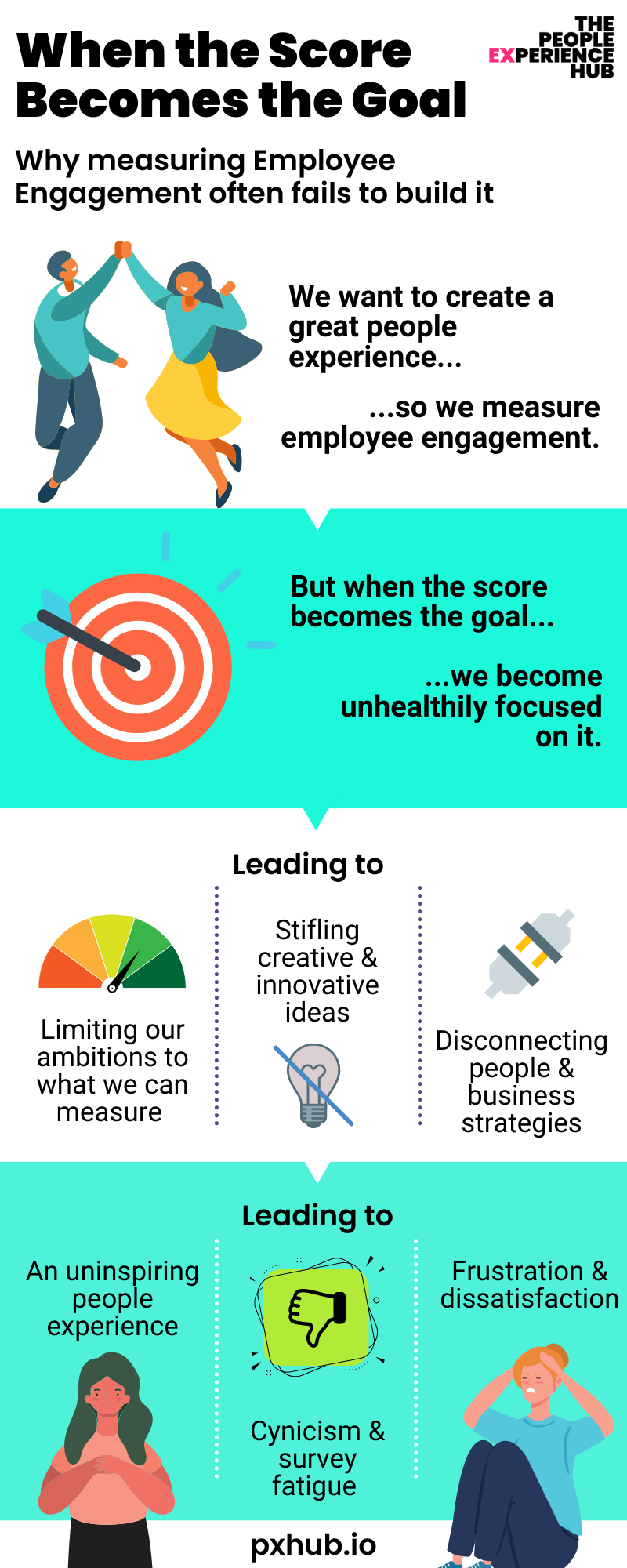There’s nothing inherently wrong with measuring employee engagement. I mean, Employee Engagement is a good thing to aspire to, and if you want to improve something why not measure it? Right? We’re not concerned, in this post, with the concept of employee engagement, which is itself fairly controversial. It’s undeniably useful to know that your people “are committed to their organisation’s goals and values, motivations to contribute to organisational success, and are able at the same time to enhance own sense of well-being.” Engage for Success And though defining and measuring employee engagement can be a of a minefield, we quite like the CIPD’s view of it as: > an umbrella term describing a broad area of people strategy and referring to narrower constructs – such as work engagement or organisational commitment – when you need to be more specific. This allows you to maintain a broad strategic focus while also prioritising your concerns and what you expect to achieve or improve. In other words, employee engagement is broad, like the people experience. And who doesn’t aspire to create a great people experience? So, accepting that there are some issues and challenges with the concept of employee engagement, let''s move on to the point of this post…
When the engagement score becomes the goal... We understand that it’s important for many organisations to have a headline measure of how well they are doing with ‘people’ that they can review at board level and perhaps even include in their annual report. But when employee engagement is used like this, the measure must not become the goal in the same way that, say, profit does. This is something that often happens when you benchmark employee engagement, but that’s another issue that we cover here ... You become unhealthily focused on it. When the employee engagement score becomes the goal, it gets in the way of seeing what really matters (which is delivering a great employee experience) in favour of trying to drive up the score. While in the process of trying to improve your score you might improve engagement, you are also in danger of missing out on opportunities to build a better business through your people. More specifically when we start focusing on the engagement score it can:
Limit your ambitions to what we can measure
It is not uncommon to see a company KPI aimed at, say, improving employee engagement by 5%. In other words, improving the score. When those KPIs get cascaded to managers and embedded into their objectives, the danger is that they start doing what they think might improve the score and not what might actually make things better for their teams. The whole exercise becomes one of box-ticking.
Stifling innovative, creative ideas When this happens, it is the more innovative, creative ideas that might be a little bit off the beaten track, and a little bit risky, that get squashed.
Disconnect people initiatives from business needs
When activities and people initiatives are assessed on their contribution to the KPI rather than HOW they will contribute to organisational performance (as defined by business strategy) they become disconnected from business needs. In this respect, ‘employee engagement’ is an abstraction; a proxy for what might drive performance and not what does. And these problems, furthermore, contribute to:
An uninspiring people experience when ambition is limited, creativity stifled and initiatives are disconnected from business strategy, how can the people experience possibly be inspiring? In seeking to improve the engagement score, the oxygen supply for engagement is cut off.
Frustration and dissatisfaction Employee engagement is, inherently, a motivational concept. If I am engaged, I am motivated. If I am not being effectively engaged, one potential consequence is that my motivations (or needs) are being frustrated or unsatisfied. And ‘work engagement'' is a positive state of mind associated with pleasant emotions, so what we might describe as frustration and dissatisfaction could easily be translated as stress.
Disengagement, cynicism and survey fatigue Furthermore, if people are not feeling the benefit of a positive people experience and start to believe that more attention is being paid to engagement scores than engaging employees, then they will disengage and become cynical about future initiatives, attempts to engage and, specifically, taking part in engagement surveys. What should you do instead?
Keep employee feedback relevant
Think carefully about what you measure, making sure that it is relevant in the context of your people strategy or the culture you want to create (and not just what a survey provider says you should measure). Ultimately, remember that you''re trying to improve people''s experience of work so that the organisation performs better.
Understand the limitations of your survey (or feedback)
Surveys are great, but they do have their limitations. They tell you where you might have issues and broadly what they are, but they’re not a precise diagnostic. You might only have, say, 40 questions to measure quite a range of themes, so you may need to dig deeper before taking action.
Use your survey results to initiate further conversations about the people experience
Whether it’s at an organisational level or within your own team, it is the conversation that survey results prompt that is their real value. If your survey suggests that there is a leadership issue, start having conversations about leadership (either formally, using interviews and focus groups, or informally). In follow up conversations, also encourage people to talk about things that the survey didn’t measure. That might lead to valuable insights that are easily missed. Don''t let your employee engagement efforts fail!
Talk to us about maximising the value from employee feedback.
---
Check out our guide to running employee surveys
When the employee engagement goal becomes the score, employee engagement:

